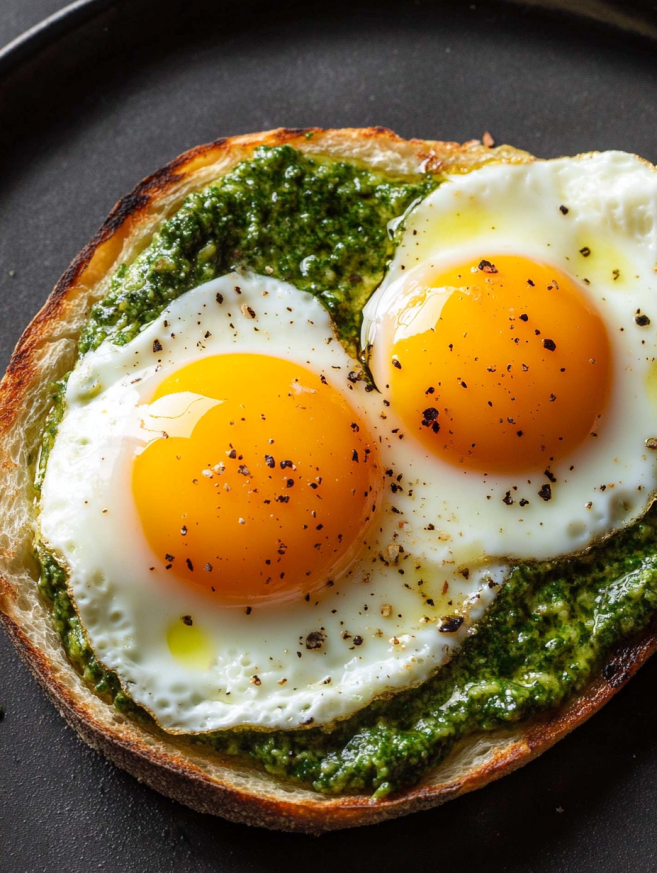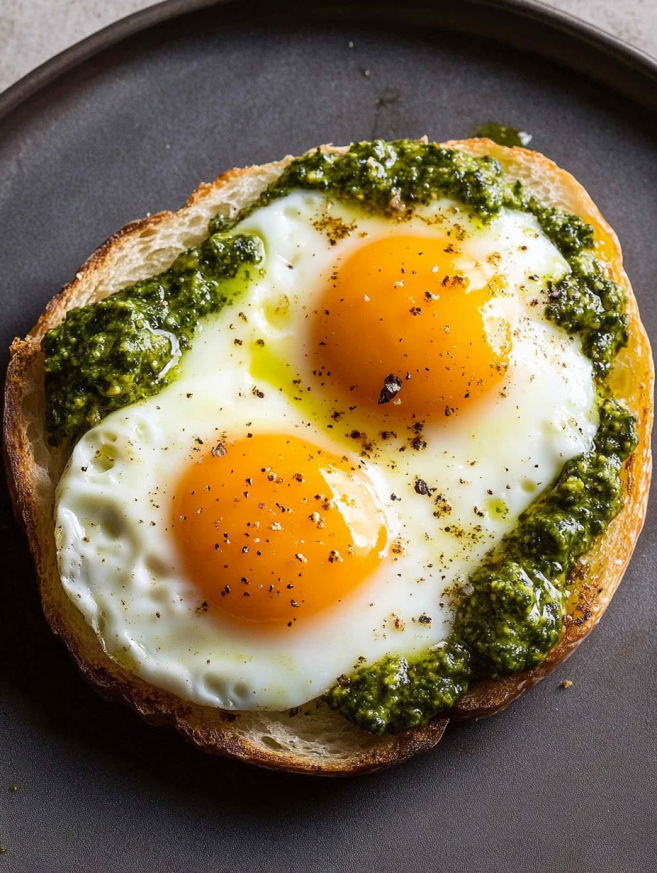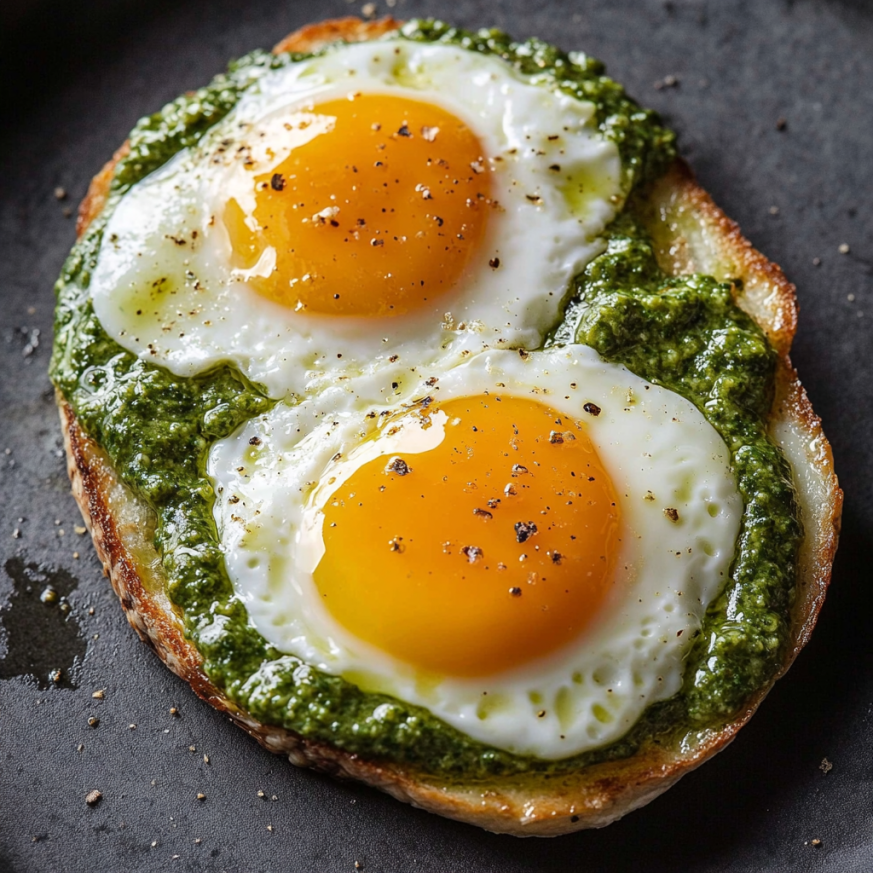I’ll admit it – I was skeptical when pesto eggs first started flooding my social media feeds. How could something so simple create such a sensation? Then I tried them on a lazy Sunday morning, and suddenly everything clicked. The aromatic basil oil gently cooking those perfect egg whites while keeping the yolks gloriously runny, all while infusing every bite with that fresh, garlicky pesto flavor – it was a revelation. Now, this has become my go-to when I want to transform ordinary eggs into something that feels genuinely special.
Why This Recipe Deserves All the Hype
Pesto eggs represent the perfect marriage of convenience and sophistication. Unlike traditional fried eggs that can feel monotonous, these bring vibrant Mediterranean flavors to your breakfast table with minimal extra effort. The pesto acts as both cooking medium and sauce, creating layers of flavor that develop as it gently heats.
Additionally, this technique produces the most beautifully textured eggs you’ll ever encounter. The gentle oil from the pesto creates perfectly puffed, bubbly whites while protecting the yolks from overcooking. Meanwhile, every component becomes infused with that irresistible basil and garlic aroma.
Most importantly, this recipe gives you homemade pesto that lasts for weeks, meaning you can recreate this magic whenever the mood strikes. It’s an investment in future delicious breakfasts.
Fresh, Quality Ingredients
For the Homemade Pesto
- 1 bunch fresh basil (about 2 cups packed leaves)
- 2 garlic cloves
- ¼ cup pine nuts
- ½ cup extra virgin olive oil
- ½ cup Pecorino Romano, freshly grated
For the Eggs
- 4 fresh eggs
- Pinch of sea salt
- Freshly cracked black pepper (optional)
Perfect Serving Companions
Consider pairing with crusty sourdough bread, avocado slices, or cherry tomatoes. Furthermore, crispy prosciutto or fresh mozzarella elevates this into a complete Mediterranean breakfast experience.
Creating the Perfect Pesto Base
Building Flavor Layers
Start by adding basil leaves, garlic cloves, and pine nuts to your food processor. Pulse briefly to begin breaking down the ingredients, allowing their essential oils to release and mingle. This initial step is crucial for developing complex flavors.
Next, drizzle in the olive oil while pulsing intermittently. You’re aiming for a chunky texture rather than a smooth paste – those little pieces of basil and nuts will provide delightful textural interest when coating your eggs.
Incorporating the Cheese
Remove the mixture from the processor and transfer to a bowl. Gradually stir in the Pecorino Romano, starting with ¼ cup and tasting as you go. The cheese should enhance the nutty, herbaceous flavors without overwhelming the fresh basil notes. Some prefer a more intense cheese flavor, so adjust according to your taste preferences.
Mastering the Cooking Technique
Preparing Your Pan
Heat a large frying pan over low heat – this gentle temperature is absolutely essential for success. Add 2-3 tablespoons of your fresh pesto, allowing it to warm slowly until you hear gentle sizzling. The oil should shimmer but never smoke or bubble aggressively.
The Gentle Cooking Method
Crack your eggs directly into the warming pesto, spacing them evenly around the pan. The key to perfect pesto eggs lies in patience and technique. Resist the urge to increase the heat, as this will result in tough, rubbery whites.
Using a spoon, carefully baste the egg whites with the hot pesto oil, creating those signature puffy, bubbled textures. However, avoid drizzling oil directly onto the yolks – this protection keeps them gloriously runny and golden. The entire process should take 4-5 minutes, allowing the whites to set completely while maintaining those perfect, jammy yolks.
Final Seasoning
Once the whites are completely opaque and slightly puffed, season the yolks with a light pinch of sea salt. This small addition brightens all the flavors and provides the perfect finishing touch.
Creative Serving Suggestions
The classic presentation involves serving these eggs over thick slices of toasted sourdough, allowing the runny yolks and flavorful pesto to soak into the bread. However, consider trying them over polenta, quinoa, or even roasted sweet potato slices for varied nutritional profiles.
For a more substantial meal, add crumbled goat cheese, sun-dried tomatoes, or fresh arugula. These Mediterranean additions complement the pesto beautifully while adding contrasting textures and flavors.

Delicious Variations to Explore
Herb Garden Version
Experiment with different herb combinations in your pesto. Try substituting half the basil with fresh spinach, arugula, or even mint for unique flavor profiles that keep this dish interesting.
Nut Alternatives
While pine nuts are traditional, toasted walnuts, almonds, or even sunflower seeds create different textures and flavors. Each variation brings its own character to the finished dish.
Cheese Swaps
Parmesan works beautifully if Pecorino Romano isn’t available. For a milder flavor, try fresh mozzarella or even ricotta mixed into the pesto for creaminess.
Smart Make-Ahead Strategies
The beauty of this recipe lies in the versatile pesto component. Prepare a full batch and store it in the refrigerator for up to two weeks, ensuring you always have the foundation for a quick, impressive breakfast ready to go.
When storing pesto, press plastic wrap directly onto the surface to prevent oxidation, or drizzle a thin layer of olive oil on top. This preserves that vibrant green color and fresh flavor that makes these eggs so appealing.
Consider freezing pesto in ice cube trays for portion-controlled servings. Each cube provides just enough for one or two eggs, making morning preparation even more streamlined.
Professional Tips for Success
Temperature control cannot be overstated in this recipe. Low, gentle heat allows the pesto to infuse the eggs without burning the delicate herbs or creating tough textures. If your pan seems too hot, remove it from heat briefly to cool down.
Fresh ingredients make an enormous difference in the final result. Use the freshest basil you can find, preferably from your garden or a local farmers market. Similarly, freshly grated cheese provides better melting properties and more intense flavor than pre-grated alternatives.
Important Notes for Perfect Results
Quality olive oil is essential since it serves as both cooking medium and flavor component. Extra virgin olive oil provides the fruity, peppery notes that complement the basil perfectly.
Don’t rush the cooking process. These eggs require patience to achieve their signature texture. Attempting to speed up the process with higher heat will result in disappointment.
Fresh herbs are non-negotiable. Dried basil simply cannot provide the bright, aromatic qualities that make this dish special.

Frequently Asked Questions
Q: Can I use store-bought pesto instead of making my own? A: While homemade pesto provides superior flavor and texture, high-quality store-bought pesto works in a pinch. Look for refrigerated versions with minimal additives for the best results.
Q: Why do my egg whites turn out tough and rubbery? A: This typically happens when the heat is too high. Keep your pan on low heat throughout the entire cooking process, and be patient with the gentle cooking method.
Q: How do I prevent my pesto from turning brown? A: Blanch your basil leaves in boiling water for 10 seconds, then immediately transfer to ice water before making the pesto. This preserves the vibrant green color for longer storage.
Q: Can I make this recipe dairy-free? A: Absolutely! Substitute the Pecorino Romano with nutritional yeast for a nutty, cheese-like flavor, or simply omit the cheese entirely for a lighter version.
Q: What’s the best way to reheat leftover pesto? A: Gently warm it in a pan over low heat, adding a splash of olive oil if it seems too thick. Never microwave pesto, as this can break down the delicate herb oils.
Q: How many eggs can I cook at once using this method? A: A large pan can typically accommodate 4-6 eggs comfortably. For larger batches, use multiple pans rather than overcrowding, which leads to uneven cooking.
Q: Is it safe to store homemade pesto for two weeks? A: Yes, when properly stored in the refrigerator with a layer of olive oil on top to prevent oxidation. Always use clean utensils when serving to avoid contamination.
Prep Time: 20 minutes | Cook Time: 8 minutes | Servings: 6

